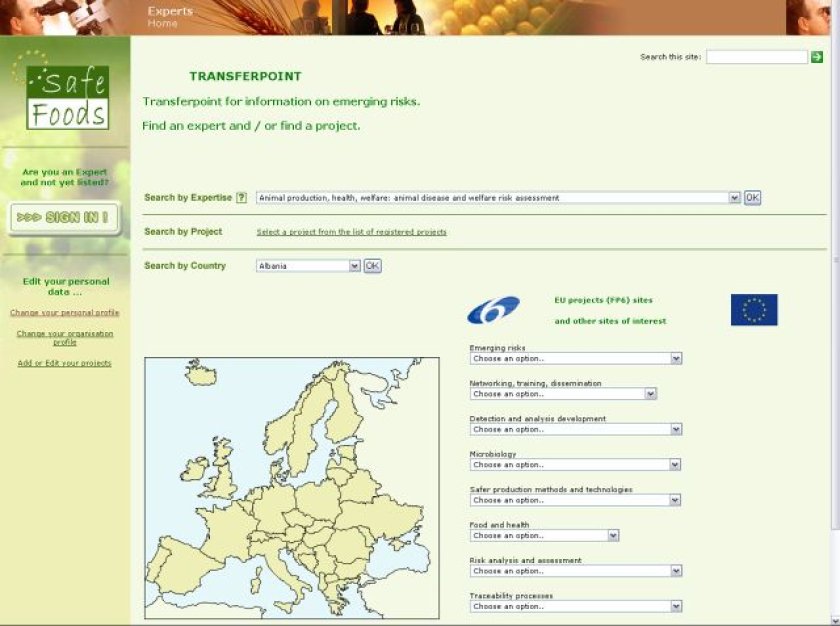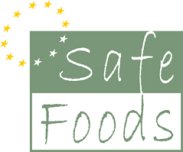
Work package 2
"Early Detection of Emerging Risks Associated with Food and Feed Production."
Identifying risks in an early stage
The goal of this work package is to assess possibilities of early identification of potential new food safety risks in an expanding European market.
The focus of this SAFE FOODS Work package is on emerging risks in the food and feed chain. Specific attention is paid to those risks that are related to high-input (intensive) and low-input (e.g. organic) farming systems and on ways to identify these risks in an early stage.
Therefore, Work package 2 (WP2) aims to establish a working procedure for the early detection and assessment of possible food and feed risk. Furthermore, WP2 is working on creating a transfer point for information on emerging food safety problems.
Different categories of risks have been identified and will be addressed in the alert system:
- Microbiological risks
- Chemical residues
- Mycotoxins (toxins produced by a fungus; mycotoxins can appear in food and animal feed as a result of fungal infection of the crop, for example in cereals, or the infection of stored products)

Activities
Several activities are being performed by WP2, these include:
- Formation of a framework to identify emerging risks at an early stage of development. How can risks be identified early to avoid a food safety crisis?
- Preparation of a report including reviews and case studies on emerging food safety risks.
- Build up of an expert database. As a template, the European Food Safety Network (EFSN) is used. This expert database will allow the identification of relevant (national) experts when a food safety problem needs to be tackled.
- Creation of an electronic platform where authorities, professionals and organisations can exchange information and alert others of potential emerging risks.
- Provide data on emerging pathogens as well as on the development of multi-resistant bacterial strains in high- and low-input agricultural systems for production of animal foods and vegetables in expanding European markets.
- Provide data on chemical residues in foods and feed produced in high- and low-input agricultural animal food production systems in expanding European markets.
- Definition of the concepts high- and low-input farming as well as organic farming.
- Creation of training courses particularly intended for officials and scientists from new Member States and Pre-accession countries. This course will focus on methods to identify emerging risks in an early phase, based upon the experiences made within this Work package and the outcomes and recommendations of the studies mentioned above. Additional information about these training courses can be found in the e-learning module site.
Progress in Workpackage 2
Definition of high- and low-input farming and organic farming concepts
The distinction between high- and low-input agriculture is important not only for this Work package, but also for others, given that SAFE FOODS focuses on the risks particularly associated with each of them. Therefore, the team members defined those terms as:
| High input/intensive | Farming that strives for maximum production |
| Low input/extensive | Farming that strives to minimise inputs (eg. pesticides, artificial fertilisers, etc.) |
| Organic | Farming as per the rules of the certification bodies within individual countries/EU |
Review on emerging pathogens and chemical risks in high- and low-input food and feed production practices
A literature review, together with surveys have been done in order to establish what exactly emerging pathogens are. Another important point to assess is whether the different production practices that are used can affect the development of these pathogens.
A similar exercise has been carried out with respect to chemical food contamination in particular focussed on problems in Central and Eastern European countries. How often and how much residues of PCB’s (such as dioxins), pesticides and mycotoxins are found in the human food chains and in feed will be described based on literature and other available data. Furthermore it will be analysed if differences in practices between low- and high-input agriculture may play a role in the contamination of food products by these chemical compounds.
This literature survey based on scientific and technical publications will be used to identify emerging pathogens and emerging chemical residues in Europe and in the rest of the world.
Reviews and Case studies
Work on several reports on the early identification of emerging microbiological and chemical risks, as well as specifically of mycotoxin-related risks have been done.
The following case studies have been included:
- Microbiological: Norwalk-like caliciviruses, protozoa (including Cryptosporidium and Cyclospora in vegetables), Listeria in smoked salmon, Salmonella in ground beef, Campylobacter in poultry, Aeromonas in farmed fish and organic vegetables, Arcobacter in organic meat, Helicobacter in intensive animal production, Non-O157 VTEC Escherichia coli in organic products
- Chemical: Botanicals (plant-based or –derived ingredients) as functional foods, unauthorized genetically modified crops, antibiotics in fish and shrimp aquaculture, meat and bone meal contamination of animal feed (BSE, TSE), dioxins in organic chicken products, dioxins and PCBs in fish
- Mycotoxins: Aflatoxin M1 in meat and dairy products and Dehoxynivalenol (DON) and Ochratoxin A in organic and conventional bread.
In addition, more general reviews have been drafted of reviews on risks associated with microorganisms and mycotoxins in food.
Set-up of transfer point containing the Food Expert database
SAFE FOODS is creating a transfer point for information on emerging food safety problems with European experts on food safety. The transfer point includes the Food Expert database, an electronic library containing known experts and expertise in the field of food safety research and assessment.
The transfer point is aimed to provide all stakeholders, i.e. scientists, regulators, food producers in particular SME’s (Small & Medium Enterprises) and consumers with adequate information at any time. The final goal is to link this transfer point database to the currently utilised Rapid Alert System (RAS) by EU Member States.

